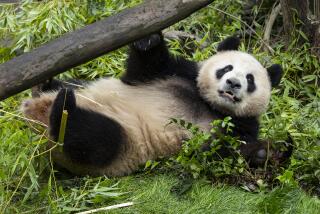In San Francisco, wild parrots need homes
- Share via
Reporting from San Francisco — The wild parrots that call San Francisco home have become a given of city life, squawking their way to their favorite spots, delighting tourists. The famous flock is now about 300 strong, more than triple what it was 10 years ago.
But that, it turns out, is good and bad news for the birds.
A local bird rescue group, which was founded to rescue abandoned pet cockatiels, is inundated with wild parrots that need care — fledglings that crash and break a wing or leg, birds stricken by illness, or those injured by predators.
The rescue group, Mickaboo Companion Bird Rescue, is overwhelmed with birds of all species, including canaries, cockatiels and amazons — many surrendered by owners grappling with hard times — and it is also handling more and more members of the wild flock.
“As a flock, it’s healthy, it’s growing,” said Jennifer Ehrlichman, the rescue’s wild-conure coordinator. “There has always been a percentage that falls ill or gets injured. The percentage hasn’t changed. There are just more birds.”
The rescue group, whose 100 members care for birds in their homes, has 225 birds of all kinds waiting to be adopted and has run out of volunteers who can take in wild parrots.
That puts the rescue in the midst of a bona fide wild parrot emergency.
Mickaboo, which has taken in 60 wild parrots since 2003, has 18 wild parrots waiting to be adopted, the most ever at one time.
Ehrlichman, a fashion designer, is fostering five cherry-headed conures, in addition to one parrot she adopted seven years ago.
“We’re getting more birds and losing more adoptive homes because of the recession,” Ehrlichman said.
The parrots, which tend to break up into small groups during the day, spreading their wings and chattering all over the city, have a fan base. They were immortalized in the 2005 documentary “The Wild Parrots of Telegraph Hill,” based on the 2004 book of the same name by Mark Bittner, and are mentioned in guidebooks and monitored by tour groups that show off the birds to visitors.
How the birds, natives of South America, came to take up residence in San Francisco is a matter of speculation, even legend. Bittner, who devoted years to chronicling and caring for them, first noticed the parrots in 1989, when the flock numbered just four — a mated pair and their offspring. The adults wore quarantine bands, suggesting they had been released by, or escaped from, importers.
By 1994, Bittner and his neighbors on Telegraph Hill counted 26 parrots. By 1999, 50.
Not all are related. The flock has included cherry-headed conures, mitred conures with half-red and half-green heads, blue-crowned conures and mitred-cherry-head hybrids.
In 2007, San Francisco banned feeding the parrots because they were falling ill to a bone disease caused by eating too many seeds and not enough of the blossoms and other food found in their habitat. They were also losing their foraging instincts and street smarts, making them easy targets for predators.
They fall prey not only to hawks, but to a tiny worm thought to come from raccoons, Ehrlichman said. The worm causes a neurological disease marked by dizziness and the inability to fly.
Some of the parrots up for adoption have fallen victim to this illness. John Graziano, a Mickaboo volunteer who is fostering seven birds, has three members of the wild flock holding court in his Berkeley living room, two of which have the illness. The other day, all three were squawking loudly in a language that wild parrot advocates say is unique to San Francisco.
“Birds that haven’t been with the flock don’t make the same noises,” Graziano said.
Mal Raff, a volunteer who has raised four of the wild parrots since they were infants, says it’s true: His birds don’t speak San Francisco wild parrot.
They do coo and kiss when visitors come to see them in their aviary in Raff’s backyard. The youngsters, nearing a year old, are up for adoption, at least in theory.
“They’re like my kids,” said Raff, a jazz musician and astrophysicist. “I couldn’t give them to just anybody.”
That’s equally true of Mickaboo. Potential adopters are put through a rigorous screening, including a home visit and a mandatory class on bird care, Ehrlichman said.
“I went through it,” she said. “Now I teach the class.”
More to Read
Sign up for The Wild
We’ll help you find the best places to hike, bike and run, as well as the perfect silent spots for meditation and yoga.
You may occasionally receive promotional content from the Los Angeles Times.






